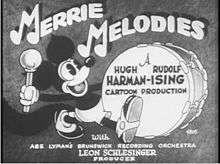Foxy (Merrie Melodies)
| Foxy | |
|---|---|
| Looney Tunes/Merrie Melodies character | |
 Foxy on the Merrie Melodies title card in 1931 | |
| First appearance | Lady, Play Your Mandolin! (Merrie Melodies, August 1931) |
| Last appearance | Two-Tone Town (Tiny Toon Adventures, September 1992) |
| Created by | Rudolf "Rudy" Ising |
| Voiced by |
Carman Maxwell or Johnny Murray (possibly) (1931) Rob Paulsen (1992) |
| Information | |
| Species | Fox |
| Gender | Male |
Foxy is an animated cartoon character featured in three 1931 animated shorts in the Merrie Melodies series distributed by Warner Bros. He was the creation of animator Rudy Ising, who had worked for Walt Disney in the 1920s.
Concept and creation
In 1925, Hugh Harman drew images of mice on a portrait of Walt Disney. Disney and Ub Iwerks would then use it as the basis for their creation of Mickey Mouse, the character who eventually became Disney's most popular.[1] Comics historian Don Markstein, calling Warner Bros. animator Rudolf Ising's subsequent Foxy "perhaps the leading Micky Mouse imitator", observed that,
Never in animation, before or since, has a character looked more like Mickey Mouse. Smooth out the tiny points that supposedly turned his big, round ears into fox ears, shave the bushiness off of his tail, and they were ringers. Do the same to his girlfriend (unnamed at the time), and she looked exactly like Minnie [Mouse]. They also acted like Mickey and Minnie did at the time. Despite this lack of originality, Foxy was the first character to originate at Warner (as opposed to being brought in from outside, like Bosko).[2]
Screen history
Merrie Melodies

Foxy was the star of the first Merrie Melodies cartoons Ising directed for producer Leon Schlesinger. (Ising had already helped his partner Hugh Harman create another series, titled Looney Tunes, with the character Bosko.) Foxy's first appearance on screen was on August 1931 in "Lady, Play Your Mandolin!". This short set in the Old West features Foxy developing affection for the tavern singer who would become his girlfriend.
Foxy and his then-nameless girlfriend would appear in another cartoon that same year: "Smile, Darn Ya, Smile!" (September 5, 1931), a musical set on a trolley. The plot bears some similarities to "Trolley Troubles", a 1928 Oswald the Lucky Rabbit cartoon to which Harman and Ising contributed. This also marks the first time Foxy's name was mentioned.
On October 3, 1931, a third short, "One More Time", was released. This musical cops-'n'-robbers cartoon would become Foxy's final appearance in the Merrie Melodies series and has the character killed off in the final scene, as a crow shoots Foxy in the back after he successfully captures a street gang.
At the end of each short, Foxy comes out from behind a bass drum and says to the viewers, "So long, folks!" Although all three shorts use sound, the voice actors are not credited.
Upon leaving Warner Bros. two years later, Ising took the rights to Foxy and two other characters he conceived. Though Ising got a job at another studio, none of the thee characters appeared in any more theatrical cartoons. All three Foxy shorts eventually went into the public domain.[3]
Later appearances
Foxy appeared along with his girlfriend (here christened "Roxy") and fellow forgotten Warner Bros. progenitor Goopy Geer in "Two-Tone Town", an episode of the animated series Tiny Toon Adventures aired on September 28, 1992. The foxes were voiced by Rob Paulsen and Desirée Goyette respectively and were redesigned for the episode. The three live in a world of black-and-white which is visited by the series' stars, Babs Bunny and Buster Bunny. Buster and Babs, feeling sorry for the old timers left in oblivion, decided to help bring Foxy, Roxy and Goopy alongside Big Bee (based on the bee from Your Too Careless With Your Kisses) back to the limelight. The efforts of the two rabbits work out but results Buster and Babs being featured in guest appearances while the characters they helped become the new TV sensations. Foxy's appearance in this episode is similar to his theatrical version, except that the tear-drop ears are replaced by pointy ones to make him appear more fox-like and less Mickey-like. Also, his shoes are simplified.
References
- ↑ Kenworthy, John The Hand Behind the Mouse, Disney Editions: New York, 2001. p. 54.
- ↑ Foxy at Don Markstein's Toonopedia. Archived from the original on July 30, 2016.
- ↑ Cooke, Jon, ed. "Looney Tunes in the Public Domain". Looney.GoldenAgeCartoons.com. Archived from the original on April 18, 2015. Retrieved April 13, 2011. Source cites Film Superlist: Motion Pictures in the U.S. Public Domain, 1894-1939, Film Superlist: Motion Pictures in the U.S. Public Domain, 1940-1949 and Film Superlist: Motion Pictures in the U.S. Public Domain, 1950-1959, all by Walter E. Hurst.
External links
- "Foxy & Roxy". ToonZone. Archived from the original on June 3, 2013.